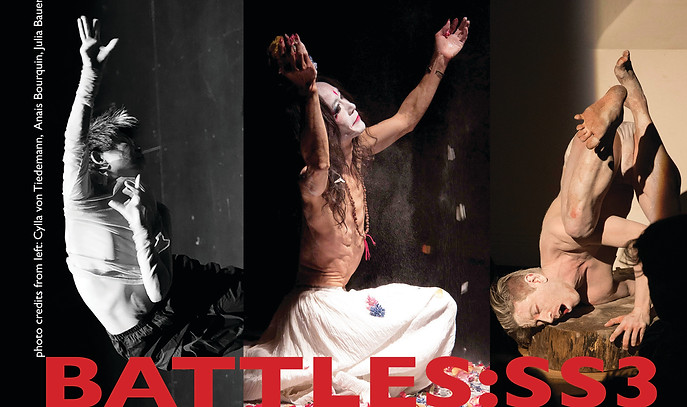top of page
SS3: Battles as the third in a series of Post-Butoh Festivals. Battles aims to transform our collective fear and the need to fight through concepts of competition. We bring together diverse audiences and performers to fight for Light. Dance is a form which uplifts the spirit, for it gives us an ability to express ourselves as individuals, without language, and reflect together, in a moment of personal victory. We can lift one another up with playful/cutting competition. To play is to experiment and experience ourselves as whole humans. This is our humanity/////
Workshops and Calendar of Events (www.butohchicago.com)
**Butoh performances invoke the spark of transformation, capturing the mystery of the live moment. Butoh originated in post-World War II Japan as a reaction to the loss of identity caused by the westernization of Japanese culture, as well as a realization that ancient Japanese performing traditions no longer spoke to a contemporary audience. One of the major developments in contemporary dance in the latter half of the 20th century, Butoh speaks to current artistic practice by combining dance, theater, improvisation and influences of Japanese traditional performing arts to create a unique art form that is both controversial and universal in its expression.**
Battles:SS3 (Post-Butoh Fest 3) April 2017
(CHICAGO) – Battles: SS3 featured both local and international artists, and included performances, workshops, films, and community dinners. It was the third in a series of Post-Butoh Festivals, Spawned Seeds in 2014 and SSII in 2015. From these events, Butoh Chicago has become a hub for cultural exchange, featuring weekly classes, intensive workshops and events that showcase this enigmatic style of contemporary dance, Butoh. “We are borrowing from another time and place of revolution. We could be the New-Neo-Dadaists, finding the voice of our culture in gesture, when words stammer to be understood.”
Venues included the Japanese Culture Center, No Nation Gallery, The Learning Machine, High Concept Labs, Eco, the Dojo, and Defibrillator Gallery. Participating artists are internationally or locally recognized for their artistic expression of Butoh in performance. In partnership with the Japanese Culture Center, Butoh Chicago is delighted to welcome visiting Japanese artists Ken Mai and Mari Osanai, who will conduct workshops and performances at the Dojo in Lakeview. Artists local to Chicago presenting their work as part of "Battles: SS3" include Kiam Marcelo Junio, Wannapa P-Eubanks, Cristal Sabbagh, Holly Chernobyl, Aurora Tabar, Peter Redgrave, Alba Soto, Darling Squire, Jenn Freeman, Allen Turner, Efrén Arcoiris, Adam Rose, April Lynn and more.
More about us in the community:
"Embracing the Darkness of the Other," Interview with Sharon Hoyer
"Invoke the spark of transformation," Creative Imposter podcast with Andrea Klunder
About the International Artists
Paul Michael Henry (Glasgow, Scotland) is a Butoh performer and organizer behind UNFIX, a Glasgow-based festival of live performance, dance, film, installation, workshop and debate that wants to unravel the knots in how we're living. Visit paulmichaelhenry.com to learn more.
Ken Mai (Helsinki, Finland) has been teaching, directing, and collaborating with acclaimed dancers, actors, musicians, sculptors and visual artists all over the world. His background includes Butoh with Kazuo Ohno and Tatsumi Hijikata, German expressionist dance styles, Noguchi gymnastics, martial arts, singing, zen, and philosophy of yoga sutras. Visit kenmaibutoh.blogspot.com to learn more.
Mari Osanai (Aomori, Japan) is an independent dancer, choreographer, Noguchi Taiso teacher. She is based in Aomori, Japan. Her workshop focuses on Noguchi Taiso combined with the influences of her early training in Tai Chi, western dance methods, and traditional folk dance. Watch a bit about her here.
About Butoh
The unique art of Butoh originated in post-World War II Japan as a reaction to the loss of identity caused by the westernization of Japanese culture, war, and the realization that a contemporary culture was in need of a schism. One of the major developments to impact contemporary dance in the 20th century, Butoh spread quickly from Japan to Asia, Europe, South and North America. Butoh combines dance, theater, improvisation and influences of Japanese traditional performing arts to create a dance form that is both controversial and universal in its expression. The dances are often based on themes of nature and the psyche, evoking images of decay and resurrection, of fear and desperation, and of eroticism, ecstasy and stillness.
READ ABOUT SSII IN THE CHICAGO TRIBUNE
Stay tuned in by following butohchicago.com
bottom of page
